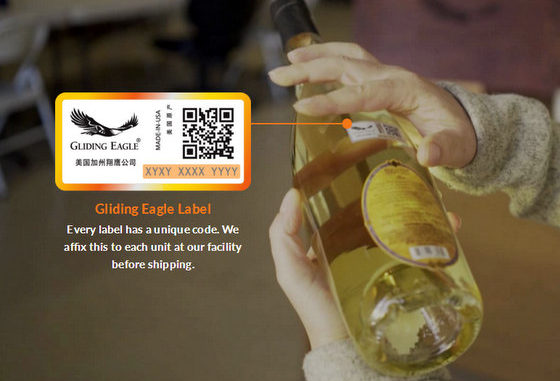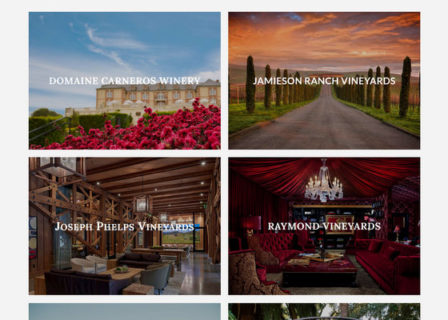

By Jim Boyce | You’re at Stag’s Leap or Mondavi or Kistler or Jordan and want to take more Napa Valley or Sonoma County nectar to China than is allowed under the two-bottle limit. You could roll the dice and smuggle a case or drop some dough to have it shipped. But what if you’re already back home, or unable to get to California in the first place, and want to order direct from the winery? A delivery system by Gliding Eagle aims to make things easier.
The timing is good given the interest of Chinese citizens in California. Nearly one million visited in 2015—tens of thousands heading to Napa—and the number might soar to 1.8 million by 2018. They tend to be big spenders, especially on luxury goods, which bodes well for California’s well-regarded wine industry.
“Right now, we just assist Chinese tourists visiting the Napa Valley to ship wine back home,” says Chris Chang, an adviser and investor at Gliding Eagle and co-owner of winery Nine Suns.
“In a couple of months we will launch an e-commerce platform that will allow consumers in China to buy directly from the winery, and insure and track it end to end,” he said. “No middlemen, just Fedex and SFExpress.”
Gliding Eagle was co-founded by Jack Duan and Adam Ivor.
Raised in Sonoma and Napa, Ivor got his MBA in Wine Business from Sonoma State, spent a decade at Highway 12 Winery with Michael Sebastiani, and now has the labels Subterra and Solid Wine Cellars.
He met Duan while doing a wine demonstration at Costco in 2010.
“He said, ‘I want to export your wines to China.’ I thought to myself, ‘Ya, I’ve heard this before’, recalls Ivor, who joined Gliding Eagle full-time in June of 2015.
“I felt that there was no good direct-to-consumer channel from the U.S. to the largest red wine market in the world,” he says. “This was a problem for me, my friends, the state of California, and for the U.S. that needed to be solved and solved well.”
They are now fine-tuning that solution.
“We are going to test directly shipping to Beijing and Tianjin in a few weeks and try going through customs there instead of Shanghai or Hong Kong,” says Chang.
He cites several advantages of the system. One is authenticity, as a unique QR code is used on each bottle. Another is price, as importers and distributors take a cut. And if large volumes are ordered, it could mean lower rates from wineries. Chang added that the company provides good storage and shipping conditions, common concerns when it comes to wine in China.
That QR code is key, says Ivor.
“In China, 700 million people have [social media app] WeChat on their phones and it has a QR code scanner built in,” he explains. “No high-tech authenticity scanner is needed, there is no need to download an app to authenticate.”
Scanning gives product info in the language the customer chooses, allows sharing with friends, provides global tracking data (see a demo here) and offers the option for ordering more wine.
“When IBM saw our technology, they gave us a USD120,000 grant to utilize their cloud based Softlayer servers around the world,” adds Ivor. “We are now a part of their Global Entrepreneurial Program.
The system’s advantages extend to sellers, says Chang.
“Producers get to know who their customers are and can follow-up directly with them, whereas with many importers and distributors, you don’t know who is buying your wine, at what price and how it was handled,” he explains.
As a winemaker, Ivor says this is crucial.
“After spending 2.5 years of my life on a product, I was not about to just put the wine in a container and say goodbye,” he says.
He says producers tend to be dependent on a distributor, who might carry a dozen or even a thousand labels, to tell their stories.
“No one can tell my story like me,” he says. “Now with cell phones and technology, I can talk to and sell directly to my customers.”
The biggest downside is time. Hand-carrying or buying from a China-based distributor means you can drink your wine right away. Buying direct from the winery requires time for everything from consolidating orders to dealing with Customs. Gliding Eagle estimates a typical wait of three weeks plus Customs time although it handles all of the bureaucracy from export papers to Customs clearance. Chang says orders under rmb2000 can be processed much faster.
While continental China is the focus, Chang said Gliding Eagle has delivered to Hong Kong, Japan, Taiwan and Singapore, with shipments totaling 3,000 bottles. These have al been for visitors to Napa and he expects the numbers to soar with the online platform.
“I’m hopeful that once we get e-commerce online, volume will grow exponentially very quickly,” says Chang. He also sees potential for a reverse flow, that is, wine shipped from China to customers in the United States.
I’ll update as I hear more about this system and other projects: Ivor noted their involvement in launching the Robert Mondavi wine club in China and Chang says the company is in negotiations with massive online retailer jd.com to offer winery-to-consumer sales for the upcoming “Wine Day” on September 9.
Want to support Grape Wall? Click here to see how. Also, sign up for the free China wine e-newsletter below. And check out sibling sites World Baijiu Day—the next one is August 9!—and Beijing Boyce.
Sign up for the Grape Wall newsletter here. Follow Grape Wall on LinkedIn, Instagram, Facebook and Twitter. And see my sibling sites World Marselan Day, World Baijiu Day and Beijing Boyce. Grape Wall has no advertisers, so if you find the content useful, please help cover the costs via PayPal, WeChat or Alipay. Contact Grape Wall via grapewallofchina (at) gmail.com.
Leave a Reply
You must be logged in to post a comment.